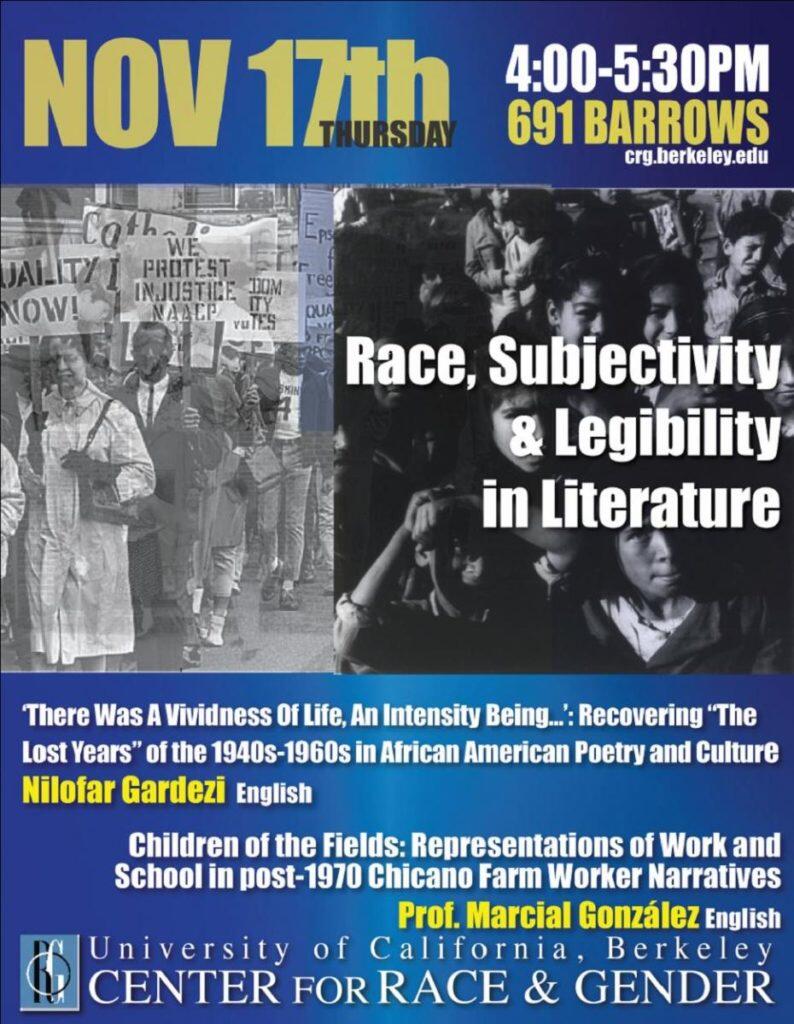Race, Subjectivity, & Legibility In Literature
11.17.2011 | 4:00 – 5:30 PM | 691 Barrows Hall
Harlem as a ‘Community in Transition’ in Langston Hughes’s Montage of a Dream Deferred
Nilofar Gardezi
My paper works to recover the “lost years” of the 1940s-1960s in African American poetry and culture. I will focus on three critically neglected African American poets Gwendolyn Brooks, Robert Hayden and Melvin Tolson and their understudied mid-century poetry to examine, formally as well as historically, how they represent the stories and lives of black women and men who helped to create and then lived in the postwar black urban communities of Chicago’s Bronzeville, Detroit’s Paradise Valley and New York’s Harlem. The dominant and totalizing story of race and representation in the postwar city is one of urban crisis, black invisibility and the formation of the blighted “black ghetto.” The smaller and textured stories of ordinary black city life in this period have been lost. I argue that, as black mid-century modernists, Brooks, Hayden and Tolson experiment with and push the limits and possibilities of narrative and characterization in modernist long form poems or poetic sequences in order to revive and represent the overlooked and everyday stories of black city life. They compose multi-voiced, multi-patterned and multi-layered poems to sustain and make widely legible portraits of burgeoning, variegated and complex black urban communities, thus revising and expanding upon a form that, with the possible exception of H.D., has been considered the exclusive domain of white male modernists like T.S. Eliot, Hart Crane, William Carlos Williams and Ezra Pound to tell other city stories. A formal appreciation of Brooks, Hayden and Tolson as energetically and assertively engaging with a tradition of modernist long form poetry has also been lost. I argue that by innovating upon this form these three poets are able to tell the commingling stories of hope and disappointment, gain and loss experienced by African Americans living in northern cities and responding to the swirling forces of Cold War containment, postwar exclusion and Civil Rights struggle of the time. Making visible these writers, their modernist work and the vivid communities of which they wrote begins the process of recovering this period in African American poetry and culture.
Children of the Fields: Representations of Work and School in post-1970 Chicano Farm Worker Narratives
Prof. Marcial González, English
In April 2011, students and faculty in the Chicano/Latino Studies Program at Michigan State University sponsored a three-day event entitled “From the Fields to the Academy: A Migrant Symposium.” One of the goals of the symposium was to recognize and document the presence of former migrant farm workers now teaching, studying, or conducting research at universities around the country. The event also served to counter the view of migrant workers as incapable of performing intellectual labor, and to inspire current students with migrant backgrounds to pursue academic careers. The symposium touched home for me in a personal way because I can relate to the seemingly incongruous experiences of working in the fields as a child and teaching at the university as an adult. I also found that the symposium’s main theme—education as a way out of the fields—is a central motif in many of the Chicano farm worker narratives that I have been studying in my current research project.
In this paper, I shall examine the way that selected Chicano narratives criticize a racist educational system but simultaneously represent education as a possible solution to the social problems faced by farm workers. This conflicted position is not without difficulties. Even if some workers or their children earn college degrees, the general working and living conditions of farm workers have not improved significantly since the founding of the United Farm Workers Union in 1966. And even though a formal education might alter the life of an individual farm worker who attends college, schooling also brings with it the liberal ideology of the capitalist system that oppresses migrant workers in the first place. These issues are represented in Chicano migrant farm worker narratives as thematic contradictions that replicate formally the actual social contradictions that farm workers face in everyday life. In analyzing the implications of this feature of Chicano narratives, I shall draw on examples from Helena María Viramontes’s novel Under the Feet of Jesus, Gary Soto’s novella Jesse, Elva Treviño Hart’s autobiography Barefoot Heart: Stories of a Migrant Child, and Robert M. Young’s film documentary, Children of the Fields.
Click here to request access to the event recording in CRG's Media Archive.

